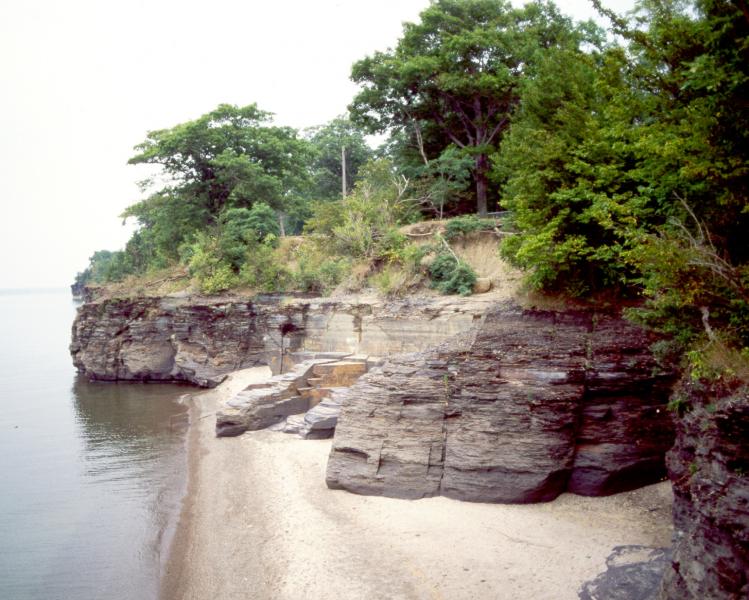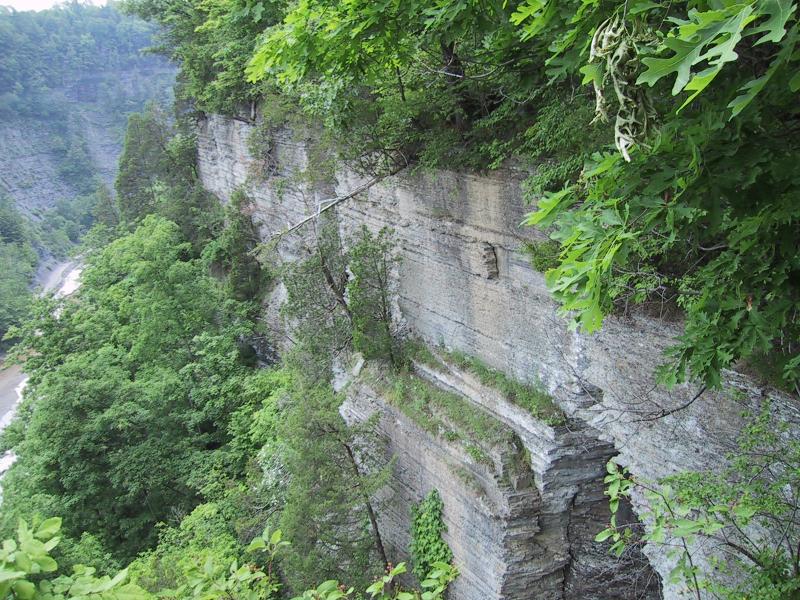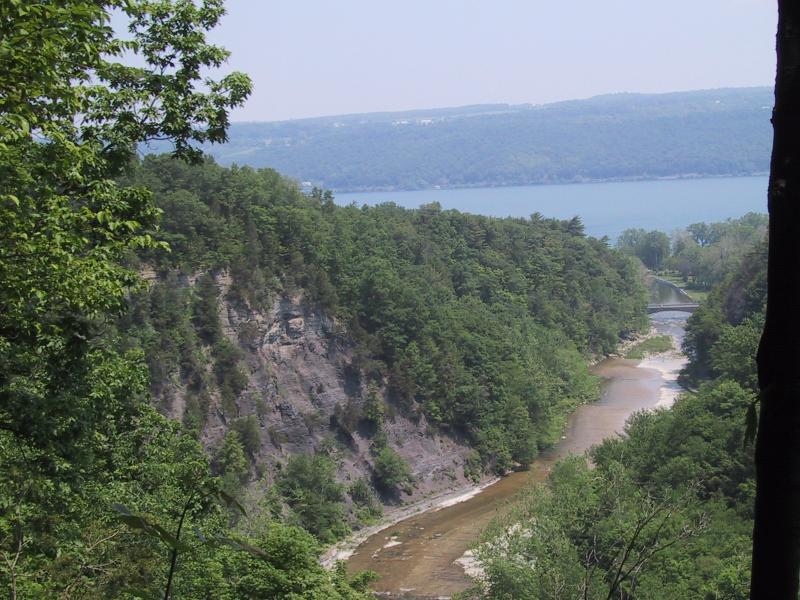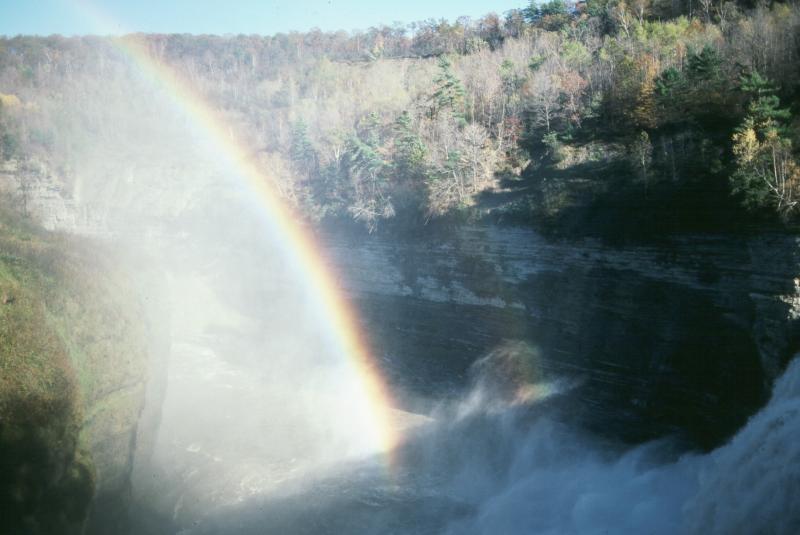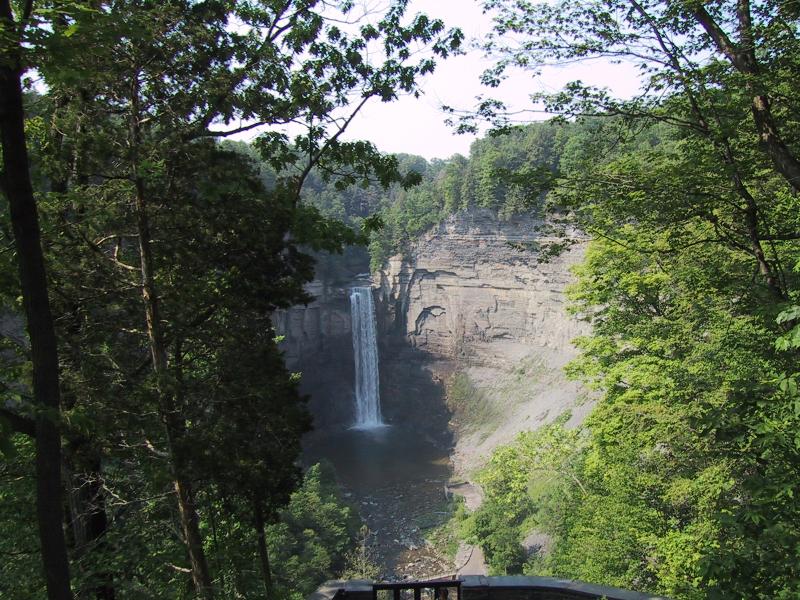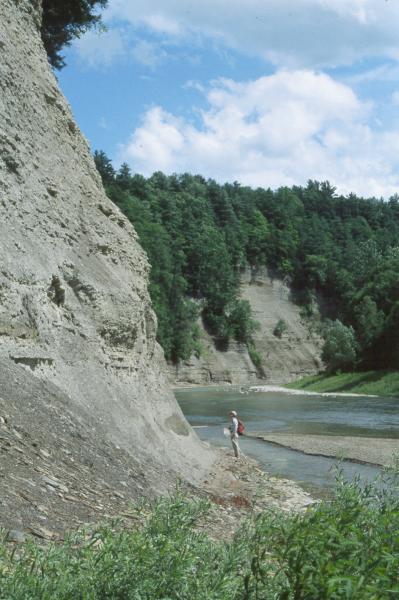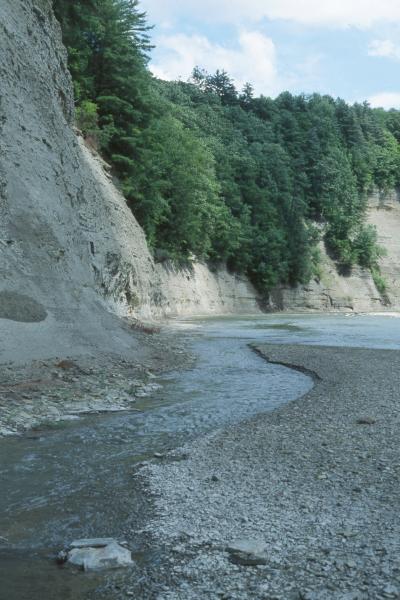Shale Cliff and Talus Community
- System
- Terrestrial
- Subsystem
- Open Uplands
- State Protection
- Not Listed
Not listed or protected by New York State.
- Federal Protection
- Not Listed
- State Conservation Status Rank
- S3
Vulnerable in New York - Vulnerable to disappearing from New York due to rarity or other factors (but not currently imperiled); typically 21 to 80 populations or locations in New York, few individuals, restricted range, few remaining acres (or miles of stream), and/or recent and widespread declines.
- Global Conservation Status Rank
- G4
Apparently Secure globally - Uncommon in the world but not rare; usually widespread, but may be rare in some parts of its range; possibly some cause for long-term concern due to declines or other factors.
Summary
Did you know?
What is talus? Talus, or scree, is a steep slope usually found at the base of a mountain. The block size of the talus is strongly influenced by the type of rock forming the cliff face and the rate of erosion; for example, shale or rapidly eroding sandstone forms unstable, small, loose talus. The unstable nature of shale results in uneven slopes and many rock crevices. Other rocky types, such as hard dolostone caprock, produces stable, very large talus that provides habitat for much larger organisms.
State Ranking Justification
There are several hundred occurrences statewide. Some documented occurrences have good viability and several are protected on public land or private conservation land. This community is limited to regions of the state with steep shale bedrock and talus outcrops, and there are several large, high quality examples. The current trend of this community is probably stable for occurrences on public land, or declining slightly elsewhere due to moderate threats that include development, trampling by visitors, and invasive species.
Short-term Trends
The number and acreage of shale cliff and talus communities in New York have probably declined slightly in recent decades as a result of development, trampling by visitors, and invasive species.
Long-term Trends
The number and acreage of shale cliff and talus communities in New York have probably declined moderately from historical numbers likely correlated with past development, trampling by visitors, and invasive species.
Conservation and Management
Threats
Shale cliff and talus communities are threatened by development in the surrounding landscape (e.g., residential, agricultural). Other threats include habitat alteration (e.g., roads and parking areas, nearby logging, and mining), and recreational overuse (e.g., trampling by visitors, ATVs, mountain bikes, campgrounds, picnic areas, swimming, rock and ice climbing, trash dumping). Threats to adjacents streams may apply to this community (e.g., alteration to hydrology, pollution, nutrient loading, impoundments and flooding, dredging). Several shale cliff and talus communities are threatened by invasive species, such as purple loosestrife (Lythrum salicaria), reed canary grass (Phalaris arundinacea), spotted starthistle (Centaurea biebersteinii), and colt's foot (Tussilago farfara).
Conservation Strategies and Management Practices
Where practical establish and maintain a natural forested buffer to reduce storm-water, pollution, and nutrient run-off, while simultaneously capturing sediments before they reach the shale cliff and talus community. Avoid habitat alteration along the cliff and surrounding landscape. Restore shale cliff and talus communities that have been affected by unnatural disturbance (e.g., remove obsolete impoundments in order to restore the natural hydrology to adjacent streams if present). Prevent the spread of invasive exotic species into the shale cliff and talus community through appropriate direct management, and by minimizing potential dispersal corridors, such as roads and trails.
Development and Mitigation Considerations
A natural (usually forested) buffer around the cliff face will help it maintain the characteristics that make it unique. It may be desirable to close portions of cliffs for various durations in order to protect rare cliff nesting birds and rare plant habitat.
Inventory Needs
Survey for occurrences statewide to advance documentation and classification of shale cliff and talus communities. Continue searching for large sites in good condition (A- to AB-ranked).
Research Needs
Research composition of shale cliff and talus communities statewide in order to characterize variations. Collect sufficient plot data to support the recognition of several distinct shale cliff and talus community types based on composition, specific geology, and by ecoregion.
Rare Species
- Allium cernuum var. cernuum (Nodding Wild Onion) (guide)
- Astragalus neglectus (Cooper's Milkvetch) (guide)
- Boechera stricta (Drummond's Rock Cress) (guide)
- Borodinia missouriensis (Green Rock Cress) (guide)
- Bouteloua curtipendula var. curtipendula (Side Oats Grama) (guide)
- Calamagrostis porteri ssp. porteri (Porter's Reed Grass) (guide)
- Conardia compacta (Coast creeping moss) (guide)
- Cornus drummondii (Rough-leaved Dogwood) (guide)
- Corydalis aurea (Golden Corydalis) (guide)
- Crotalus horridus (Timber Rattlesnake) (guide)
- Draba arabisans (Rock Whitlow Grass) (guide)
- Dryopteris fragrans (Fragrant Cliff Fern) (guide)
- Falco peregrinus (Peregrine Falcon) (guide)
- Myotis leibii (Eastern Small-footed Myotis) (guide)
- Myriopteris lanosa (Woolly Lip Fern) (guide)
- Pinguicula vulgaris (Butterwort) (guide)
- Plestiodon anthracinus (Coal Skink) (guide)
- Primula mistassinica (Bird's Eye Primrose) (guide)
- Rhodiola integrifolia ssp. leedyi (Leedy's Roseroot) (guide)
- Saxifraga aizoides (Yellow Mountain Saxifrage) (guide)
- Solidago rigida var. rigida (Stiff Flat-topped Goldenrod) (guide)
Range
New York State Distribution
This community is scattered throughout upstate New York, north of the North Atlantic Coast Ecoregion, where the bedrock is shale. Shale bedrock is essentially limited to parts of the High Allegheny Plateau, Western Allegheny Plateau, Great Lakes, and Lower New England Ecoregions. In the Great Lakes Ecoregion, this community is concentrated in the western portion, and is suspected to extend northeast primarily to the escarpment of the Tug Hill. Small disjunct occurrences are known from the northern portion of Lake Champlain.
Global Distribution
This physically broadly-defined community may be worldwide, where the bedrock is shale. Examples with the greatest biotic affinities to New York occurrences are suspected to span north to southern Canada, west to Michigan, southwest to Ohio and Tennessee, southeast to Virginia, and northeast to eastern New York and Vermont.
Best Places to See
- Four Brothers Islands Preserve, Adirondack Park
- Taughannock Falls State Park (Tompkins County)
- Letchworth State Park (Livingston, Wyoming Counties)
- Neversink River Preserve (Orange County)
- Watkins Glen State Park (Schuyler County)
- Peebles Island State Park (Saratoga County)
- Fillmore Glen State Park
Identification Comments
General Description
A community that occurs on nearly vertical exposures of shale bedrock and includes ledges and small areas of talus. Talus areas are composed of small fragments that are unstable and steeply sloping; the unstable nature of the shale results in uneven slopes and many rock crevices. There is minimal soil development, and vegetation is usually sparse. Different types of shale cliffs may be distinguished based on exposure and moisture.
Characters Most Useful for Identification
Characteristic species include blunt-lobed woodsia (Woodsia obtusa), rusty woodsia (W. ilvensis), penstemon (Penstemon hirsutus), herb robert (Geranium robertianum), cyperus (Cyperus filiculmis), little bluestem (Schizachyrium scoparium), panic grass (Panicum linearifolium), Pennsylvania sedge (Carex pensylvanica), golden sedge (C. aurea), ox-tongue (Picris spp.), and eastern red cedar (Juniperus virginiana). Characteristic bryophyte species on calcareous shale and mudstone cliffs can include the mosses Bryum pseudotriquetrum, Campylium chrysophyllum, Encalypta procera, Fissidens bryoides, Gymnostomum aeruginosum, Mnium marginatum, Myurella siberica, and the leafy liverwort Cololejeunea biddlecomiae. A characteristic invertebrate is the silvery blue butterfly (Glaucopsyche lygdamus lygdamus), which feeds on wood-vetch (Vicia caroliniana).
Elevation Range
Known examples of this community have been found at elevations between 10 feet and 1,850 feet.
Best Time to See
These dramatic shale exposures are stunning year-round.
Shale Cliff and Talus Community Images
Classification
International Vegetation Classification Associations
This New York natural community encompasses all or part of the concept of the following International Vegetation Classification (IVC) natural community associations. These are often described at finer resolution than New York's natural communities. The IVC is developed and maintained by NatureServe.
- Hairy Beardtongue Sparse Vegetation (CEGL006535)
- Shale Cliff Sparse Vegetation (CEGL006436)
NatureServe Ecological Systems
This New York natural community falls into the following ecological system(s). Ecological systems are often described at a coarser resolution than New York's natural communities and tend to represent clusters of associations found in similar environments. The ecological systems project is developed and maintained by NatureServe.
- North-Central Appalachian Circumneutral Cliff and Talus (CES202.603)
Characteristic Species
-
Trees > 5m
- Juniperus virginiana var. virginiana (eastern red cedar)
- Quercus rubra (northern red oak)
-
Shrubs 2 - 5m
- Acer spicatum (mountain maple)
- Fraxinus americana (white ash)
- Tsuga canadensis (eastern hemlock)
- Ulmus rubra (slippery elm)
-
Shrubs < 2m
- Rubus allegheniensis (common blackberry)
- Rubus odoratus (purple-flowering raspberry)
- Salix eriocephala (heart-leaved willow, Missouri willow)
-
Vines
- Parthenocissus quinquefolia (Virginia-creeper)
-
Herbs
- Aquilegia canadensis (wild columbine, red columbine)
- Aralia racemosa (spikenard)
- Cinna latifolia (drooping wood-reed)
- Cystopteris fragilis (fragile fern)
- Danthonia spicata (poverty grass)
- Eutrochium maculatum var. maculatum (spotted Joe-Pye-weed)
- Hypericum perforatum ssp. perforatum (common St. John's-wort)
- Leucanthemum vulgare (ox-eye daisy)
- Lycopus uniflorus (northern bugleweed, northern water-horehound)
- Poa compressa (flat-stemmed blue grass, Canada blue grass)
- Solidago canadensis var. canadensis (Canada goldenrod)
- Tussilago farfara (colts-foot)
-
Nonvascular plants
- Conocephalum conicum
Similar Ecological Communities
- Acidic talus slope woodland
(guide)
Shale cliff and talus communities tend to be steeper and have few to no trees on shale rock. Whereas, acidic talus slope woodlands are not as steep and have at least 25% cover of trees on more acidic rock, such as granite, quartzite, or schist.
- Calcareous cliff community
(guide)
The bedrock of a calcareous cliff community consists of limestone, dolomite, or calcareous shales as opposed to the circumneutral shales of a shale cliff and talus community. Calcareous cliff community vegetation is characterized by calcium-loving species such as purple-stem cliff-brake (Pellaea atropurpurea), bulblet fern (Cystopteris bulbifera), and Virginia saxifrage (Saxifraga virginiensis).
- Calcareous shoreline outcrop
(guide)
Calcareous shoreline outcrops are located along lakes, rivers, and streams, and they experience significant amounts of wave and ice scouring. This distinguishes them from shale cliff and talus communities, which occur on vertical exposures at slightly higher elevation.
- Calcareous talus slope woodland
(guide)
Shale cliff and talus communities occur on shale, tend to be steeper and usually sparsely vegetated, and typically have few to no trees. Whereas, calcareous talus slope woodlands occur on less steep talus slopes composed of calcareous rock such as limestone or dolomite, and have at least 25% cover of trees.
- Shale talus slope woodland
(guide)
While both communities occur on shale rock, shale cliff and talus communities tend to be steeper and usually sparsely vegetated, and typically have very few to no trees. Whereas, shale talus slope woodlands are not as steep and have at least 25% cover of trees.
Vegetation
Percent cover
This figure helps visualize the structure and "look" or "feel" of a typical Shale Cliff and Talus Community. Each bar represents the amount of "coverage" for all the species growing at that height. Because layers overlap (shrubs may grow under trees, for example), the shaded regions can add up to more than 100%.
Additional Resources
References
Edinger, G. J., D. J. Evans, S. Gebauer, T. G. Howard, D. M. Hunt, and A. M. Olivero (editors). 2014. Ecological Communities of New York State. Second Edition. A revised and expanded edition of Carol Reschke’s Ecological Communities of New York State. New York Natural Heritage Program, New York State Department of Environmental Conservation, Albany, NY. https://www.nynhp.org/ecological-communities/
Edinger, Gregory J., D.J. Evans, Shane Gebauer, Timothy G. Howard, David M. Hunt, and Adele M. Olivero (editors). 2002. Ecological Communities of New York State. Second Edition. A revised and expanded edition of Carol Reschke's Ecological Communities of New York State. (Draft for review). New York Natural Heritage Program, New York State Department of Environmental Conservation. Albany, NY. 136 pp.
Hotchkiss, Neil. 1932. A botanical survey of the Tug Hill plateau. New York State Museum Bulletin No. 287. Albany, NY.
Larson, D.W., U. Matthes, and P.E. Kelly. 2000. Cliff Ecology: Pattern and Process in Cliff Ecosystems. Cambridge University Press, New York, New York.
New York Natural Heritage Program. 2024. New York Natural Heritage Program Databases. Albany, NY.
New York Natural Heritage Program. No date. Field forms database: Electronic field data storage and access for New York Heritage ecology, botany, and zoology. New York Natural Heritage Program, New York State Department of Environmental Conservation. Albany, NY.
Reschke, Carol. 1990. Ecological communities of New York State. New York Natural Heritage Program, New York State Department of Environmental Conservation. Latham, NY. 96 pp. plus xi.
Van Diver, Bradford B. 1985. Roadside Geology of New York. Mountain Press Publishing Company, Missoula, MT.
Links
About This Guide
This guide was authored by: Aissa Feldmann
Information for this guide was last updated on: November 13, 2023
Please cite this page as:
New York Natural Heritage Program. 2024.
Online Conservation Guide for
Shale cliff and talus community.
Available from: https://guides.nynhp.org/shale-cliff-and-talus-community/.
Accessed July 26, 2024.
